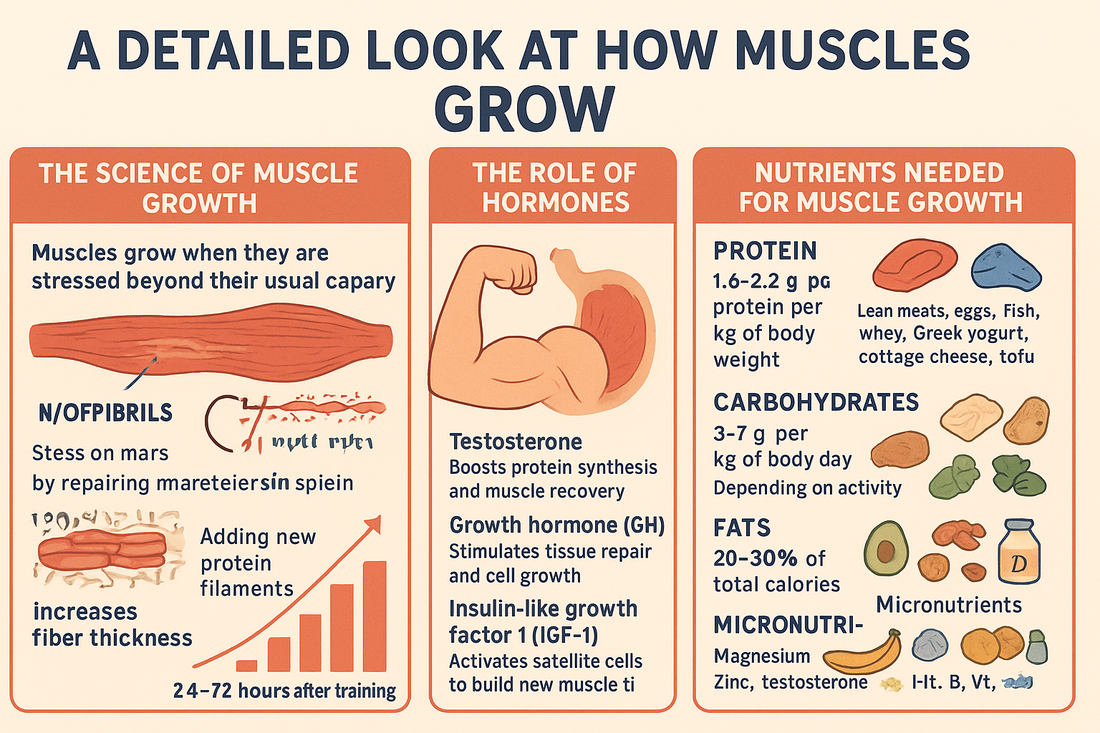
A Detailed Look at How Muscles Grow: The Science, Nutrients, and Workouts Behind Hypertrophy
Share
Muscle growth — or hypertrophy — is one of the body’s most fascinating adaptive processes. It’s not just about lifting weights or eating protein. It’s a coordinated biological response involving your muscles, hormones, nervous system, and nutrition. Let’s break down exactly how it happens and what your body needs to make it work.
1. The Science of Muscle Growth (Hypertrophy)
Muscles grow when they are stressed beyond their usual capacity — usually through resistance training or other forms of intense muscular effort. This stress causes microtears in muscle fibers (specifically in the myofibrils — the contractile units within muscle cells).
Your body perceives this damage as a threat and responds by:
- Repairing the damaged fibers with satellite cells (muscle stem cells),
- Adding new protein filaments (actin and myosin) inside the muscle fibers, and
- Increasing fiber thickness — resulting in stronger, larger muscles.
This process unfolds over 24 to 72 hours after training and depends on recovery, nutrition, and hormonal balance.
There are two main types of muscle hypertrophy:
- Myofibrillar hypertrophy: Increases strength and density by adding contractile proteins.
- Sarcoplasmic hypertrophy: Increases muscle size and glycogen storage (often seen in bodybuilders).
2. The Role of Hormones
Several hormones play a role in muscle growth:
- Testosterone: Boosts protein synthesis and muscle recovery.
- Growth hormone (GH): Stimulates tissue repair and cell growth.
- Insulin-like Growth Factor 1 (IGF-1): Activates satellite cells to build new muscle tissue.
- Insulin: Helps transport nutrients into muscle cells.
- Cortisol (in excess): Breaks down muscle tissue — why stress management and rest matter.
3. Nutrients Needed for Muscle Growth
Muscle tissue can’t grow without the right building blocks and fuel. Here’s what’s essential:
Protein – The Foundation
Muscles are made of protein, so dietary protein is critical.
- Goal: 1.6–2.2 g of protein per kg of body weight daily.
- Best sources: Lean meats, eggs, fish, whey, Greek yogurt, cottage cheese, tofu.
Carbohydrates – The Fuel
Carbs replenish glycogen stores, fuel training sessions, and help recovery.
- Goal: 3–7 g per kg of body weight daily depending on activity.
- Best sources: Rice, oats, potatoes, fruits, vegetables, whole grains.
Fats – The Hormonal Support
Healthy fats support testosterone and cell membrane health.
- Goal: 20–30% of total calories.
- Best sources: Avocado, olive oil, nuts, seeds, fatty fish, egg yolks.
Micronutrients
- Magnesium: Muscle contraction and relaxation.
- Zinc: Testosterone and recovery.
- Vitamin D: Muscle function and strength.
- B vitamins: Energy metabolism.
- Electrolytes (Na, K, Ca): Prevent cramps and maintain contraction efficiency.
Water
Muscle tissue is ~75% water. Even mild dehydration reduces strength and slows recovery.
4. The Exercises That Stimulate Growth
Muscle hypertrophy comes from progressive overload — gradually increasing the challenge placed on your muscles.
Best Types of Exercise
-
Compound movements: Work multiple muscles and stimulate the greatest growth response.
Examples: Squat, deadlift, bench press, pull-up, overhead press, row. -
Isolation exercises: Target specific muscles for detail and proportion.
Examples: Bicep curls, leg extensions, tricep pushdowns, lateral raises.
Training Variables
- Load (weight): 65–85% of your 1RM (one-rep max) for hypertrophy.
- Reps: 6–12 per set.
- Sets: 3–6 per exercise.
- Rest: 60–90 seconds between sets.
- Frequency: Each muscle group 2× per week.
- Tempo: Controlled eccentric (lowering phase) to increase muscle damage.
5. The Recovery and Growth Phase
Muscle growth doesn’t happen in the gym — it happens afterward, during rest and recovery.
Key Factors:
- Sleep: 7–9 hours per night for optimal hormone release.
- Rest days: Prevent overtraining and give tissues time to rebuild.
- Post-workout nutrition: Protein (20–40g) + carbohydrates (40–80g) within 2
